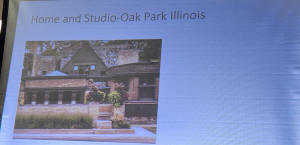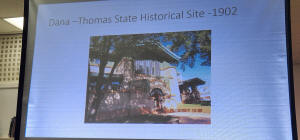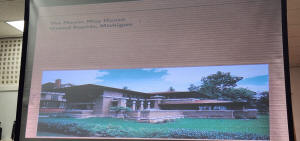|

When Alexander was a college student on a Wright plus
tour, she visited the Frank Lloyd Wright Home and Studio in Oak
Park, Illinois. Wright completed the construction of this home in
1889. At his home and studio, there is an inglenook, which Alexander
said is a cozy setting with chairs around the fireplace.
Wright’s home and studio had an inscription over the rounded
fireplace with the quote, “truth is life, good friend, around these
hearthstones speak no evil word of any creature.” Alexander said it
essentially means “no gossip.”

Wright’s home and studio had a barreled vaulted
ceiling in the playroom. Alexander said the ceiling was shaped like
a barrel and was a style Wright used quite a bit. The grille
ceilings have natural colors. The backyard has a Gingko tree
courtyard.
In the home and studio, Alexander said Wright had drafting tables he
used when designing.
Another house in Oak Park designed by Wright is the Harem House.
Alexander said on the Wright tours, there are long lines of people
waiting to see the house.
In River Forest, Illinois is the Chauncey Williams house, which has
a small rounded doorway. Alexander said Wright made people look
around for the front door often putting shrubbery in front of it so
they had no idea where to go in.

Peoria, Illinois has two houses designed by Wright.
One is the Francis Little house, which also has a rounded front
door. In the living room is a large sconce and the dining room
ceiling has indirect light. Alexander said the stable and garage was
added in 1909. One of the more recent owner’s daughters lived in an
apartment above the stable.
Many furnishings in this house were sold by a couple who later lived
in the Francis Little House. Alexander said some furnishings went to
Christies’ Auction house including oak chairs, the secretary that
was ripped out from the wall, door windows, a Teco (terra cotta)
vase and sconces.

Nearby Springfield, Illinois has the Dana Thomas
House Wright designed in 1902. Alexander said Wright had an open
checkbook to finish the house and spent every dime making the house
beautiful. It is the largest house Wright ever designed. Wright and
his wife Oglivana visited the house to admire his work.
Susan Lawrence Dana originally owned the prairie style house.
Alexander said Dana was married multiple times and had several last
names. Sometimes during seances, Dana would use all her last names.

Charles Thomas, owner of the Thomas Publishing House,
bought the house with all its furnishing from Dana in 1944.
Alexander said people working at the house would find something out
of place, put a tag on the item and put the item in a drawer. They
saved everything from the house including doorknobs and soiled area
rugs. The Thomases paid $17,500 for the house.
In 1981, the state of Illinois purchased the Dana Thomas House.
Alexander said the house was well intact. The house was then
preserved restored. The name Dana Thomas refers to its two owners.
Long narrow Roman brick was used to build the house. Alexander said
Wright had the contractors dig out the grout to measure how deep
they would need to dig. The vertical parts of the brick were filled
in with grout.
Most of the frieze, which were decorative elements in the house were
tossed in the dumpster. Alexander said it was made out of plaster
and horsehair made to look like copper. She has a small piece of
frieze. Some of the pieces are in a New York museum.
Along the front of the Dana Thomas House is a walkway. Guided tours
of the house (done by Alexander and other interpreters) start with
the carriage house.
The house staff uncovered a lily pond. It was restored to make a
reflective pool.
The lobby on the first level has a sculpture Wright
had Richard Bock design. The back of the sculpture is inscribed with
a poem by Alfred Lord Tennyson titled “Flowers in the crannies
wall.”
Tennyson’s poem says:
Flower in the crannied wall,
I pluck you out of the crannies,
I hold you here, root and all, in my hand,
Little flower—but if I could understand
What you are, root and all, all in all,
I should know what God and man is.
[to top of second column] |

The front entryway has an inglenook and a fireplace.
Another fireplace is in the living room.
Behind the dining room table is a breakfast nook in an outcropping.
Inside the house, Wright specified that sumac, goldenrod and purple
aster be part of the decorative design. Dana wanted a butterfly
theme, so butterflies are another part of the décor.

Wright designed various stained glass features
including windows, doors and light panels for the house, too.
A skylight is over the house’s billiard room.
The gallery leads to the playroom. Alexander said kids would present
plays in the gallery. They would get into their costumes upstairs.
There is a library, and its bookcases were once full. Alexander said
on Saturdays, Susan Lawrence Dana would let neighborhood children
come get books from her library.
Downstairs is a bowling alley that used duckpins, which are smaller
than normal bowling pins.
In an auction years ago then Illinois Governor James Thompson bought
one of the lamps and a music cabinet to be given back to the Dana
Thomas House.
After showing many photos of the Dana Thomas House, Alexander then
showed some photos of the Unity Temple in Oak Park, Illinois. She
walked into the temple one day and saw Wright’s son, who had been in
a meeting there.
In River Forest, Illinois is architect Robert Spencer’s House.
Spencer shared offices with Wright. Alexander said Spencer copied
many of Wright’s designs. Spencer also owned a window factory where
he experimented with casement windows. Wright’s secretary Isabell
Roberts lived in another house in River Forest.
Thirty-seven states have homes designed by Wright. One house
Alexander showed a photo of is the G.C. Stockman House in Mason
City, Iowa. Another photo was of the Meyer May House in Grand
Rapids, Michigan. Alexander said this house is owned by Steelcase
Office Furniture and is open to the public.

Alexander said many of the homes designed by Wright
have plaques in front of them that tell the history of the house.
Some of the homes Wright designed no longer stand. For example,
Alexander said the Northome in Minnesota was demolished in 1972.
Fortunately, a New York museum reconstructed the living room of the
home for an exhibit.
In Tokyo, Japan, Wright designed the Imperial Motel, but it is gone
now too. Alexander said some of the China designed by Wright and
used in the hotel is still being made and sold.
Another design by Wright is the “Romeo and Juliet” windmill in
Spring Green, Wisconsin. Alexander said the windmill was built in
1896, rebuilt in 1938 and restored in 1992.
Someone asked Alexander how she became interested in the work of
Frank Lloyd Wright.
In response, Alexander said she has a degree in Interior Design and
used to live in Springfield. Riding her bike around the area also
helped Alexander develop interest in Wright’s work.

Wright’s ashes are sprinkled around the grounds of
Taliesin West, which was his home and studio in Wisconsin. Alexander
said Wright had been buried near there with a wrought iron
gravestone, but Olgivana Wright later had him dug up and cremated.
As Alexander ended her presentation, she shared Wright’s quote “God
save us from architectural historians.”
The annual Logan County and Genealogical Historical Society dinner
and meeting will be held Monday, November 18 at Daphnes’ Restaurant
at 6:30 p.m. Chuck Fricke will be the speaker.
For those wanting to attend the dinner, reservation forms can be
picked up at the LCGHS building and must be turned in by November 8.
[Angela Reiners]
|